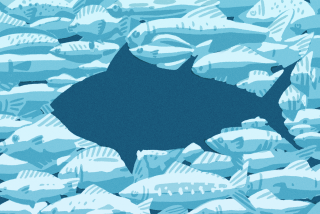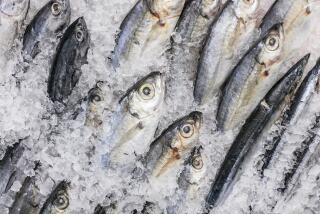Dolphin-Safe Tuna Fishing Is Aim of Bumble Bee Study
- Share via
SAN DIEGO — In an effort to ensure that Pacific Ocean zones off the Americas remain active but dolphin-safe fisheries, Bumble Bee Seafoods Inc. announced a research program Wednesday to learn how fishermen can lure their desired catch--tuna--away from dolphin-rich areas.
The $500,000 study, to be conducted by the National Marine Fisheries Service and the Inter-American Tropical Tuna Commission, seeks to capitalize on the tuna fish’s propensity to associate with floating debris.
If tuna can be persuaded to follow human-made floats instead of dolphins, researchers say, fishermen will be able to set their nets without fear of killing marine mammals.
And the San Diego-based cannery’s tarnished reputation among environmentalists could be improved as well, the firm acknowledges.
“If we’re successful, that will provide a mechanism for catching large tuna without catching dolphins,” said James Joseph, director of the tuna commission, a nonprofit research group. But he called the study a “gamble,” because so little is known about why tuna find floating objects so attractive.
Mike McGowan, a Bumble Bee vice president and director of its Alternative Fishing Technologies program, said the company hopes that the study will encourage U.S. fishermen to continue fishing in the Eastern Tropical Pacific, a triangular section of the Pacific Ocean bounded by San Diego, Chile and Hawaii.
That 7.5-million-square-mile region is the only place where dolphins often swim directly over schools of tuna. And until last year many skippers used dolphins there as markers to indicate where to set their nets.
But since April, 1990, when the world’s three largest tuna canners--Bumble Bee, Long Beach-based StarKist and St. Louis-based Chicken of the Sea--agreed to stop buying and selling tuna caught with dolphins, many U.S. fishermen have chosen to drop their nets elsewhere.
In one year, the number of U.S. fishing boats working in the Eastern Tropical Pacific has slipped from 30 to nine, according to one estimate--a shift that is inconvenient for Bumble Bee and other companies that rely on tuna processing plants in Puerto Rico, just across the Panama Canal from the Eastern Tropical Pacific. Furthermore, McGowan acknowledged, Bumble Bee hopes that its study of human-made, radio-equipped floats--called “fish aggregate devices,” or FADs--will help remedy any damage done to the company’s image last December. That was when an environmental group placed full-page newspaper advertisements attacking the company’s environmental integrity.
The group, the San Francisco-based Earth Island Institute, accused Bumble Bee and its Thailand-based parent company, Unicord, of continuing to accept tuna caught in nets that maim dolphins. Bumble Bee fired back with ads that defended its products as dolphin-safe.
The company had decided before that exchange to fund the study announced Wednesday, McGowan said.
“To have made that commitment and get slammed was especially hard,” he said, adding that Bumble Bee now is on much better terms with animal-protection advocates. “We’ve worked all those things out.”
David Phillips, Earth Island’s executive director, on Wednesday applauded Bumble Bee’s research project.
“We are very supportive of developing alternatives that don’t require any chasing or encircling of dolphins, so the FADs we think are a very good direction to be looking in,” he said.
Phillips cautioned, however, that such technologies are only useful in the context of firm dolphin-safe policies. “The commitment from the various industries to stop setting nets on dolphins is more important than the commitment to try to find the alternate technologies,” he said. Scientists unveiled a few of the FADs at a news conference Wednesday on a boat off the San Diego coast. Later this month, they plan to set 60 FADs of various designs adrift in the ocean. It will take months before the devices become “seasoned” and attract fish. Monitoring of the results will help shape the rest of the study.
Researchers stressed that they are in the early stages of understanding why tuna have been observed congregating around floating logs or palm fronds.
One theory is that the objects provide some protection from predators. Another is that because currents often sweep floating objects into organically rich areas, fish have “learned” to stick close--an adaptation that could lead fish to their next meal.






